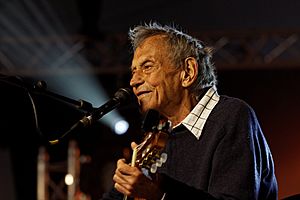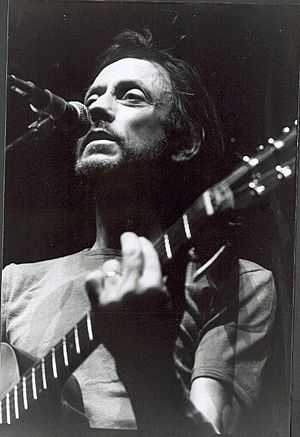Graeme Allwright facts for kids
Quick facts for kids
Graeme Allwright
|
|
|---|---|

Graeme Allwright in 2012
|
|
| Background information | |
| Born | 7 November 1926 Wellington, New Zealand |
| Died | 16 February 2020 (aged 93) Couilly-Pont-aux-Dames, France |
| Genres | Contemporary folk music, protest songs, chanson, jazz |
| Occupation(s) | Singer, songwriter |
| Instruments | Guitar |
| Years active | Early 1960s–2020 |
Graeme Allwright (born 7 November 1926 – died 16 February 2020) was a singer and songwriter. He was born in New Zealand but became famous in France. He was very popular in the 1960s and 1970s. Graeme was known for singing French versions of songs by American and Canadian artists. Some of these artists included Leonard Cohen, Bob Dylan, and Pete Seeger. He continued to perform even when he was in his nineties.
Contents
Life and Career
Early Life and Moving to France
Graeme Allwright was born in Wellington, New Zealand. He grew up in a town called Hāwera. Later, he went to Wellington College. As a child, he listened to jazz and American folk songs on the radio. These songs were broadcast for US soldiers in New Zealand. He also sang with his family at local fairs.
When he was 15, Graeme started acting in Wellington. He won a special award to study at the Old Vic theatre school in London. He traveled to England by working as a cabin boy on a ship. In London, he trained and worked as an actor. He was offered a place at the famous Royal Shakespeare Company. However, he decided not to join. Instead, he moved to France in 1948. He went with his girlfriend, Catherine Dasté. She was also a theatre student. Her father was a famous actor and director named Jean Dasté.
In France, Allwright worked as a carpenter building theatre sets. While working, he slowly learned to speak French very well. He and Catherine got married in 1951. They later divorced.
Starting a Music Career
After acting, Allwright worked in vineyards in Burgundy, France. He also ran a theatre group in Pernand-Vergelesses. During this time, he learned to play the guitar. He listened to music by American singers like Woody Guthrie, Tom Paxton, and Pete Seeger. He lived in Blois and worked in a hospital. Then, he moved to Dieulefit. There, he taught English and started a children's theatre group.
Graeme found he was good at changing stories from New Zealand into French for his students. Later, he moved to Saint-Étienne. This is where he began changing American songs into French. In the early 1960s, he started singing in small clubs in Paris. He met other singers like Colette Magny and Marcel Mouloudji. They were very impressed by how well he could adapt songs by Bob Dylan and Leonard Cohen into French.
First Albums and Success
Marcel Mouloudji helped Graeme Allwright record his songs. In 1965, Graeme released his first music. It was an EP called "Le Trimardeur." This song was adapted from Woody Guthrie's "Hard Travelin'." Then, he released his first full album, also called Graeme Allwright. This album had French versions of songs by Guthrie and Oscar Brand. It also included songs by French writer Paul Koulak and some of Graeme's own music.
Graeme then signed a contract with Mercury Records. His second album, also named Graeme Allwright, came out in 1968. It featured French versions of Bob Dylan's "Who Killed Davy Moore?" and Malvina Reynolds' "Little Boxes." His own song, "Il faut que je m'en aille (Les retrouvailles)," was also on the album. This album became very popular with students during the May 68 protests in France.
Graeme Allwright's music became like anthems for young people in France who wanted change. His biggest success was his third album, Le jour de clarté (1968). This album included French versions of two songs by Leonard Cohen. These were "Suzanne" and "The Stranger Song." It also had songs by Tom Paxton, Pete Seeger, Jackson C. Frank, and Roger Miller. His most popular song was the title track, "Le jour de clarté." It was adapted from the Peter, Paul and Mary song "Very Last Day."
The sudden success of the song made Graeme feel stressed. He left his family in France and went traveling. He first went with a friend to Egypt and Ethiopia. He spent six months in the city of Harar. He said he did not even think about his singing career. He was living a completely different life and discovering a new world.
In 1970, he released the album A long distant present from thee..."Becoming". This was a collaboration with other musicians. It was described as a "psychedelic album" inspired by his travels in India. He then released an English-language album, Recollections (1971). After that came Jeanne d'Arc (1972), which had his own songs and more by Leonard Cohen.
Travels and Continued Music
Over the next few years, Graeme Allwright often recorded an album and then left France. He would travel in Africa, India, and the Americas. This made him even more popular in France. In the mid-1970s, he lived for 18 months on Réunion, an island in the Indian Ocean.
He became friends with Leonard Cohen, who liked Graeme's French versions of his songs. In 1973, Allwright released the album Graeme Allwright chante Leonard Cohen. In the same year, he released a double live album called A l'Olympia. He continued to release albums throughout the 1970s. His last album of that decade was Condamnés? in 1979.
In 1980, he played a series of concerts with Maxime Le Forestier. These concerts were recorded on the album Enregistrement Public au Palais des Sports. The money earned from this album was given to children's charities. In 1985, he released an album of songs by Georges Brassens.
Graeme Allwright also spoke out against things he believed were wrong. He protested against the French government's nuclear testing in the Pacific. He also protested against the sinking of the Rainbow Warrior in 1985.
Later Years and Legacy
Later in his life, Allwright worked on music for films. He also recorded an album of songs for children. In 2000, he released the album Tant de Joies. This was a collaboration with American jazz trombonist Glenn Ferris. In 2005, he made a rare trip back to New Zealand to perform. He continued to perform into the 2010s. He wanted to share his message of peace and fairness in society.
In the 2000s, Graeme Allwright worked with Sylvie Dien. They wrote new words for the French national anthem, "La Marseillaise." They wanted to make it a song about peace instead of war.
Allwright was also well known for his French version of the Christmas song "Old Toy Trains" by Roger Miller. He called his version "Petit Garçon." In 2014, this song became the official song for the annual French charity event Téléthon 2014. The song was recorded by the event's sponsor, Canadian French singer Garou. A young singer named Ryan also sang on the track. It was also on Garou's Christmas album It's Magic, released in December 2014.
A book about Graeme Allwright, called Graeme Allwright par lui-même, was published in 2018. It was written by Jacques Vassal.
Death
Graeme Allwright passed away at the age of 93 on 16 February 2020. He had been living in a retirement home in Seine-et-Marne, France, for a year. His daughter, Jeanne, shared the news of his death.
Discography
Albums
- Graeme Allwright (also known as Le trimardeur), 1965, BAM.
- Graeme Allwright (also known as Joue, joue, joue), 1966, Mercury.
- Le jour de clarté, 1968, Mercury.
- Recollections, 1970, Mercury.
- A Long Distant Present from Thee ... "Becoming,", 1971, Mercury 6459 100.
- Jeanne d'Arc, 1972, Mercury.
- Graeme Allwright chante Leonard Cohen, 1973, Mercury.
- À l'Olympia, 1973, Mercury.
- De passage, 1975, Mercury.
- Questions..., 1978, Mercury.
- Condamnés?, 1979, Mercury.
- Graeme Allwright et Maxime Le Forestier enregistement au Palais des Sports, 1980, Mercury.
- Ombres, 1981, Mercury.
- Lumière, 1992, EPM.
- Live, 1994, EPM.
- Graeme Allwright & The Glenn Ferris Quartet, 2000, EPM.


